Small overlap front
The small overlap front evaluation consists of a driver-side and a passenger-side component. If the results of the two evaluations differ, then the combined small overlap rating is equal to the lower rating.
Driver-side
- Rating applies to 2019-25 models
Tested vehicle: 2019 Volvo XC40 T5 Momentum 4-door 4wd
The Volvo XC40 was introduced in the 2019 model year.
| Evaluation criteria | Rating |
|---|---|
| Overall driver-side evaluation | |
| Structure and safety cage | |
| Driver injury measures | |
| Head/neck | |
| Chest | |
| Hip/thigh | |
| Lower leg/foot | |
| Driver restraints and dummy kinematics | |
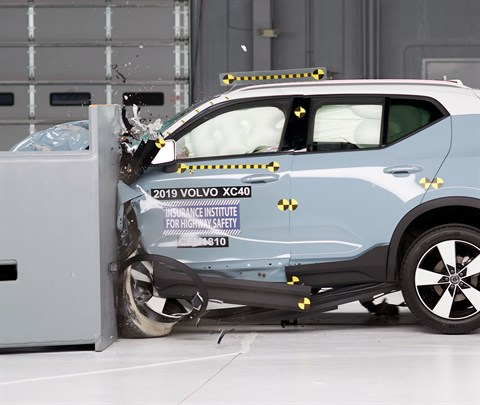
Action shot taken during the driver-side small overlap frontal crash test.
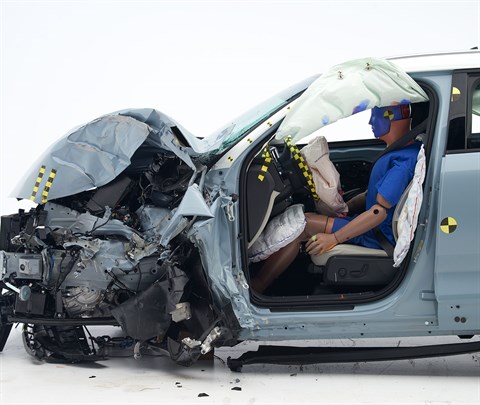
The dummy's position in relation to the door frame, steering wheel, and instrument panel after the crash test indicates that the driver's survival space was maintained very well.

The frontal and side curtain airbags worked well together to keep the head from coming close to any stiff structure or outside objects that could cause injury.

The driver's space was maintained well, and risk of injuries to the dummy's legs and feet was low.
Passenger-side
- Rating applies to 2019-25 models
Tested vehicle: 2019 Volvo XC40 T5 4-door 4wd
The Volvo XC40 was introduced in the 2019 model. Passenger-side small overlap frontal ratings are assigned by the Institute based on a test conducted by Volvo.
| Evaluation criteria | Rating |
|---|---|
| Overall passenger-side evaluation | |
| Structure and safety cage | |
| Passenger injury measures | |
| Head/neck | |
| Chest | |
| Hip/thigh | |
| Lower leg/foot | |
| Passenger restraints and dummy kinematics | |
| Driver injury measures | |
| Head/neck | |
| Chest | |
| Hip/thigh | |
| Lower leg/foot | |
| Driver restraints and dummy kinematics | |
Moderate overlap front: updated test
Rating applies to 2021-25 models
Tested vehicle: 2021 Volvo XC40 T5 Momentum 4-door 4wd
The Volvo XC40 was introduced in the 2019 model year.
| Evaluation criteria | Rating |
|---|---|
| Overall evaluation | |
| Structure and safety cage | |
| Driver injury measures | |
| Head/neck | |
| Chest | |
| Thigh/hip | |
| Leg/foot | |
| Driver restraints and dummy kinematics | |
| Rear passenger injury measures | |
| Head/neck | |
| Chest | |
| Thigh | |
| Rear passenger restraints and dummy kinematics | |
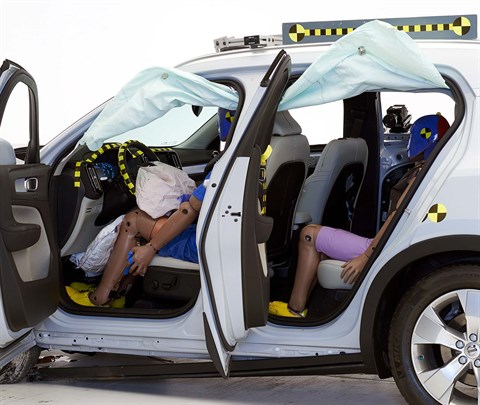
View of the vehicle after the crash showing the airbags and damage to the occupant compartment.
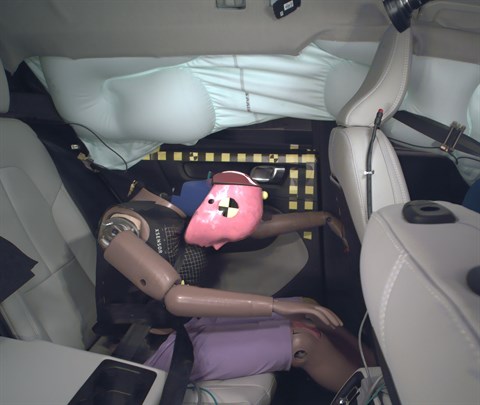
The rear passenger dummy's head remained a safe distance from the front seatback.
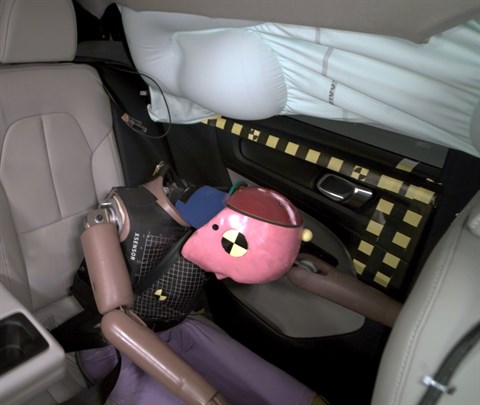
Rear passenger dummy injury values indicate a low risk of injury to the head or neck and chest. During the crash, the shoulder belt remained in an ideal position on the dummy’s chest.
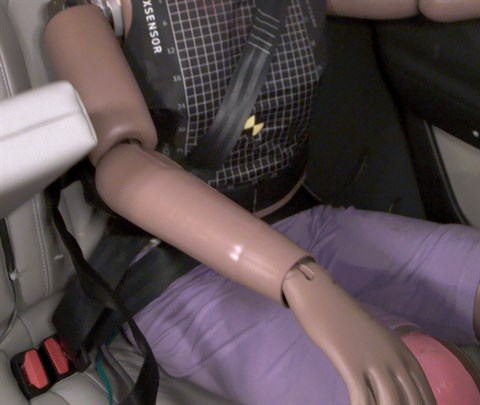
The rear passenger dummy's lap belt remained in the ideal position on the pelvis.
Side: original test
Rating applies to 2019-25 models
Tested vehicle: 2019 Volvo XC40 T5 Momentum 4-door 4wd
The Volvo XC40 was introduced in the 2019 model year. Side ratings are assigned by the Institute based on a test conducted by Volvo.
| Evaluation criteria | Rating |
|---|---|
| Overall evaluation | |
| Structure and safety cage | |
| Driver injury measures | |
| Head/neck | |
| Torso | |
| Pelvis/leg | |
| Driver head protection | |
| Rear passenger injury measures | |
| Head/neck | |
| Torso | |
| Pelvis/leg | |
| Rear passenger head protection | |
Side: updated test
Rating applies to 2019-25 models
Tested vehicle: 2021 Volvo XC40 T5 Momentum 4-door 4wd
The Volvo XC40 was introduced in the 2019 model year.
| Evaluation criteria | Rating |
|---|---|
| Overall evaluation | |
| Structure and safety cage | |
| Driver injury measures | |
| Head/neck | |
| Torso | |
| Pelvis | |
| Driver head protection | |
| Rear passenger injury measures | |
| Head/neck | |
| Torso | |
| Pelvis | |
| Rear passenger head protection | |
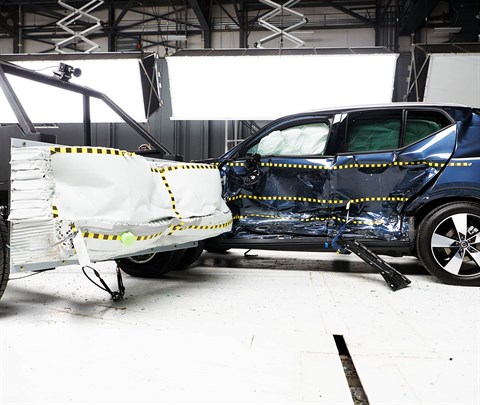
View of the vehicle just after the crash test.
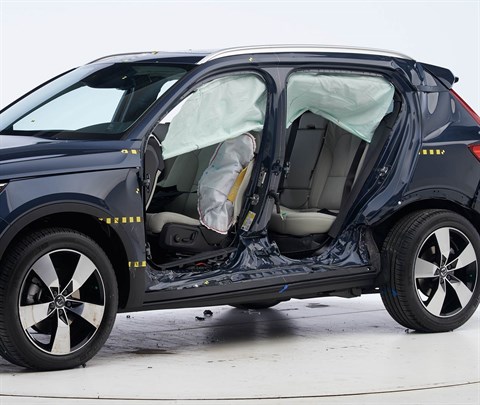
View of the vehicle after the crash with doors removed, showing the side airbags and damage to the occupant compartment.
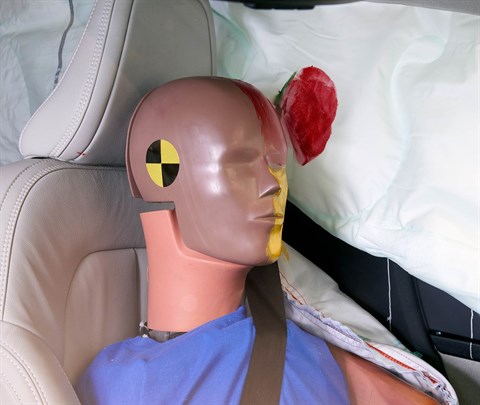
Smeared greasepaint shows where the driver dummy's head was protected from being hit by hard structures by the side airbags.
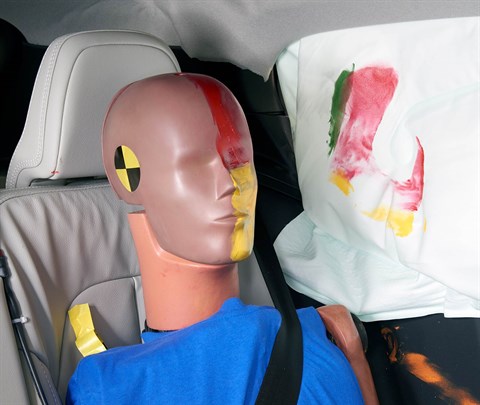
Smeared greasepaint shows where the rear passenger dummy's head was protected by the side airbag.
Front crash prevention: pedestrian (day)
Seat belt reminders
Rating applies to 2023-25 models
| Evaluation criteria | Rating |
|---|---|
| Overall evaluation | |
| Front row | |
| Unbelted occupant alert (audible & visual) | |
| Initiation time | |
| Duration | Long enough (90+ seconds) |
| Volume | |
| Audio frequency | |
| Second row | |
| Startup status alert (visual) | |
| Initiation time | |
| Duration at least 60 seconds | |
| Belt disengaged alert (audible & visual) | |
| Initiation time | |
| Duration at least 30 seconds | |
| Volume | |
| Audio frequency | |
